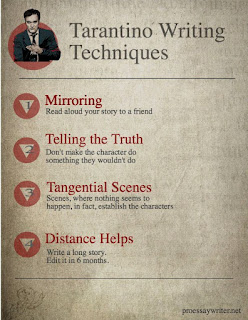To experience narrative transportation, the audience should experience empathy with the characters. Social psychologists Geoff Kaufman and Lisa Libby argue that when audiences take the perspectives and experiences of the characters in the story they “lose themselves and assume the identity of the character, adopting the character’s thoughts, emotions, goals, traits, and actions and experiencing the narrative as though they were that character.”
As postulated by Green and Brock (2002), imagery indeed seems to play an important role in transportation. Using a more fine-grained measure of perceived imagery ability than in previous research (Green et al., 2008), the present study demonstrated that transportation into a narrative and identification with its protagonist vary across different media depending on recipients’ perceived ability to generate vivid mental imagery.- People perceive less intent to persuade.
- People identify with and like the characters and then adopt the beliefs of those characters.
- People may remember the events in a story as their own.(In an Aside, below, there is a link to an article on this phenomena of False Memories)
All that means to me is I can go further with the story, and keep my reader with me.
The Ten Commandments of Emotional Connection:
i. From Consumers → to People
Emotional branding allows companies to create a relationship with its consumers that is based on mutual respect. This approach would help potential consumers to have a positive attitude towards the product, creating an attraction between the brand and the items being sold without being forced to purchase.
Emotional branding creates an emotional memory between the buyer and the product as a form of connection that goes beyond need. Need is based on price and convenience, buying the product experience has an added value to it which money won’t be able to buy.
iv. From Quality → to Preference
Emotional Branding helps a brand become a consumer’s preference. The quality is an essential factor to stay in business, however achieving preferential status by consumers mean that the product made a real connection with its users.
v. From Notoriety → to Aspiration
Emotional Branding shapes a business to be an aspiration instead of simply being known. Brand awareness creates familiarity with its users but to be attain success, the brand must be able to inspire the user to be desired.
vi. From Identity → to Personality
Emotional Branding teaches a company to build its personality to create a lasting impact on users. Brand personalities form charismatic attitude that would trigger positive emotional response towards the brand.
vii. From Function → to Feel
Emotional Branding makes experience as an important factor in creating brand identity. The product may perform according to its practical function, but emotional branding enables the user to have a deeper emotional experience while using the product.
viii. From Ubiquity → to Presence
Similar with having an experience, emotional branding promotes brand presence as it also creates an impact on potential users, ensuring a permanent connection with people.
ix. From Communication → to Dialogue
Emotional branding encourages to have a conversation with its target audience. It means that there should be a dialogue from the company relayed to the target audience via personal message to share actual experiences with the product.
x. From Service → to Relationship
Emotional branding helps create a special relationship between the brand and its loyal users. Creating a relationship with the consumers is perhaps the most important aspect of emotional branding because the company intends to have a deep connection with its customers and it will create an important bond among its users.
~ As Listed by Marc Gobé
Emotional branding uses the consumer's ability to process messages to promote a significant feeling associated with the brand.The two types of processing that a person can use to comprehend branding are Active Processing, which is learning that happens when deep, attentive processing is being applied, or, Implicit processing, which is when meaning can be processed without awareness. Emotional branding is quite complex, in that a person can interpret a brand image through attentive processing, but once their emotions are provoked, the meaning that they take from the brand image can be implicitly processed, or in other words, subconsciously created.
There are multiple techniques for achieving an emotional response to a brand. The first, and perhaps the most complicated method is by attaching the brand to a certain set of ideological values. This works best when the advertiser has done substantial amounts of research on the demographic audience, knowing what values and ideas will trigger an emotional response and connection to the brand. The values can be embedded into the brand through images and language. An example of this would be the family values and essence of childhood and bonding portrayed in Walt Disney World Ads.
Emotional branding uses a series of themes and symbols to create meaning for a consumer. In this sense, "theme" means a concept or story line that is present throughout an ad, and if integrated well-enough, throughout the brand. A "symbol" is representative of the theme. Vance Packard's The Hidden Persuaders suggests that the symbol represents a promise and consumers buy the promise. The text reads, "The cosmetic manufacturers are not selling Lanolin, they are selling hope. We no longer buy oranges, we buy vitality. We do not buy just an auto, we buy prestige."
As suggested in Edward Bernays' The Engineering of Consent, Themes must appeal to human motivations in order to be successful. Motivation lies deep with a person's subconscious desires to achieve or meet certain goals. Bernays suggests that there is an extensive list of factors that drive motivation based on both ideological values and personal experience.
There are a few techniques used with symbolism. The first is making the theme and symbol of a brand continuously publicized. The second technique is making sure that the theme and symbol hold substance and promote a specific idea about the company. The company symbol needs to be adaptable to a changing society while standing firmly as a set of values.
Symbols can represent multiple themes simultaneously, as suggested by Bernays. For example, a kitten can represent both playfulness and comfort. Symbols provide a promise for a sense of fulfillment associated with their brand. Vance Packard highlights the eight hidden needs that consumers have that themes and symbols attempt to sell. The eight needs are as follows:
- Emotional security
- Reassurance of worth
- Ego-gratification
- Creative outlets
- Love objects
- Sense of power
- Sense of roots
- Immortality
A second method of emotional branding is making a literal statement about a product and its association to emotion. An example of this can be seen in a 1966 Hamlet Cigar ad that states “Happiness is a cigar called Hamlet.” This associates the brand with a particular emotion in the most literal way possible.
It is important to note that emotional branding is something that comes with time and long standing presence. For example, attachment of the specific emotion of “nostalgia” to the Kodak brand of film, “bonding” to the Jim Beam bourbon brand, and “love” to the McDonald’s brand are built over time. Through repetition of these themes and symbols, these brand names have reached brand euphoria, where meaning no longer needs to be created, as enough branding has been done to solidify the brand image.


















